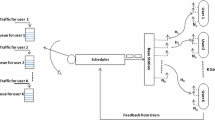Abstract
In this paper, we presents an analytical link capacity and outage performance analysis of downlink multiuser diversity (MUD) in multiple-input multiple-output (MIMO) system employing maximal-ratio combining (MRC) with transmit antenna selection (TAS) in the presence of imperfect channel state information (CSI) due to feedback delay over Rayleigh fading channels. The unified achievable analysis is appropriate for MUD–MIMO with TAS/MRC systems in which effective output signal-to-noise ratio (SNR) is specified as highest order statistic of chi-square distribution. Based on this framework, the closed-form channel capacity and outage probability expressions are examined for the MUD–MIMO exploiting TAS/MRC with normalized SNR based scheduling in heterogeneous wireless networks. Further, we derive approximate upper bound capacity as well as capacity at high SNR and low SNR region under delayed feedback CSI. The upper and lower bound of outage probability under delayed feedback CSI is also evaluated. Thereafter the impact of feedback delay and antenna structures with significance on the consideration of MUD on the performance of the system has been analyzed.




Similar content being viewed by others
References
Vishwanath, S., Jindal, N., & Goldsmith, A. (2003). Duality, achievable rates, and sum-rate capacity of Gaussian MIMO broadcast channels. IEEE Transactions on Information Theory, 49(10), 2658–2668.
Caire, S. G., & Shamai, S. (2003). On the achievable throughput of a multi-antenna Gaussian broadcast channel. IEEE Transactions on Information Theory, 49, 1691–1706.
Yu, W., & Cioffi, J. (2004). Sum capacity of Gaussian vector broadcast channels. IEEE Transactions on Information Theory, 50(9), 1875–1892.
Sharma, N., & Ozarow, L. (2005). A study of opportunism for multiple-antenna systems. IEEE Transactions on Information Theory, 51(5), 1804–1814.
Yang, L., & Alouini, M.-S. (2006). Performance analysis of multiuser selection diversity. IEEE Transactions on Vehicular Technology, 55(3), 1003–1018.
Chen, C. J., & Wang, L. C. (2006). A unified capacity analysis for wireless systems with joint multiuser scheduling and antenna diversity in Nakagami fading channels. IEEE Transactions on Communications, 54(3), 469–478.
Ajib, W., & Haccoun, D. (2005). An overview of scheduling algorithms in MIMO based fourth-generation wireless systems. IEEE Network, 19(5), 43–48.
Chauhan, S. S., & Kumar, S. (2015). Channel capacity of TAS/MRC system with adaptive transmission and channel estimation errors. Telecommunication Systems. doi:10.1007/s11235-015-0124-4.
Bai, D., Mitran, P., Ghassemzadeh, S. S., Miller, R. R., & Tarokh, V. (2009). Rate of channel hardening of antenna selection diversity schemes and its implication on scheduling. IEEE Transactions on Information Theory, 55(10), 4353–4365.
Zhang, X., Chen, F., & Wang, W. (2007). Outage probability study of multiuser diversity in MIMO transmit antenna selection systems. IEEE Signal Processing Letters, 14(3), 161–164.
Torabi, M., Haccoun, D., & Ajib, W. (2009). Capacity and outage probability analysis of multiuser diversity in MIMO MRC systems with transmit antenna selection. IEEE Pacific Rim conference on communications, computers and signal processing, pp. 59–64.
Torabi, M., & Haccoun, D. (2011). Performance analysis of joint user scheduling and antenna selection over MIMO fading channels. IEEE Signal Processing Letters, 18(4), 235–238.
David, H. A. (1970). Order statistics. New York: Wiley.
Gradshteyn, I. S., & Ryzhik, M. (2000). Table of integrals, series, and products (6th ed.). San Diego, CA: Academic.
Lopez, J., & Anton-Haro, C. (2006). Analytical assessment of multiuser versus spatial diversity trade-offs with delayed channel state information. IEEE Communications Letters, 10(8), 588–590.
Giinther, C. G. (1996). Comment on estimate of channel capacity in Rayleigh fading environment. IEEE Transactions on Vehicular Technology, 45(2), 401–403.
Simon, M. K., & Alouini, M. S. (2000). Digital communication over fading channels: A unified approach to performance analysis. New York: Wiley.
Bahceci, I., Duman, T. M., & Altunbasak, Y. (2003). Antenna selection for multiple-antenna transmission systems: Performance analysis and code construction. IEEE Transactions on Information Theory, 49, 2669–2681.
Author information
Authors and Affiliations
Corresponding author
Rights and permissions
About this article
Cite this article
Chauhan, S.S., Kumar, S. Channel capacity and outage probability analysis of multiuser diversity MIMO MRC systems with antenna selection in the presence of delayed feedback. Telecommun Syst 64, 559–567 (2017). https://doi.org/10.1007/s11235-016-0192-0
Published:
Issue Date:
DOI: https://doi.org/10.1007/s11235-016-0192-0




